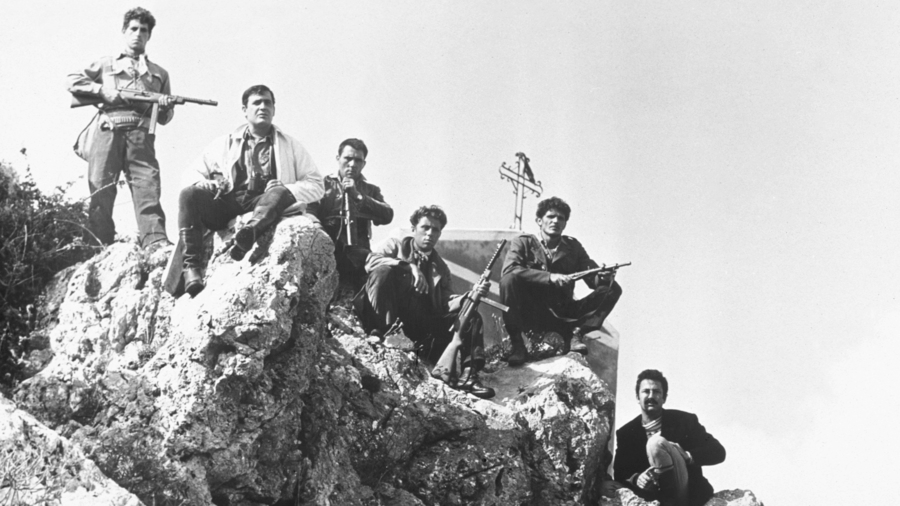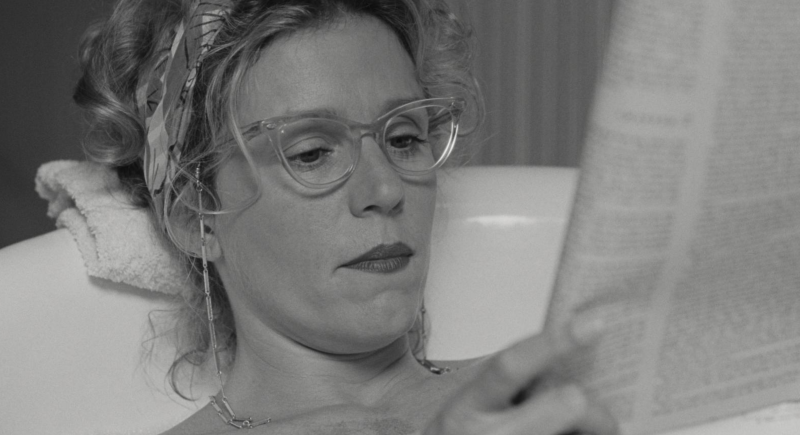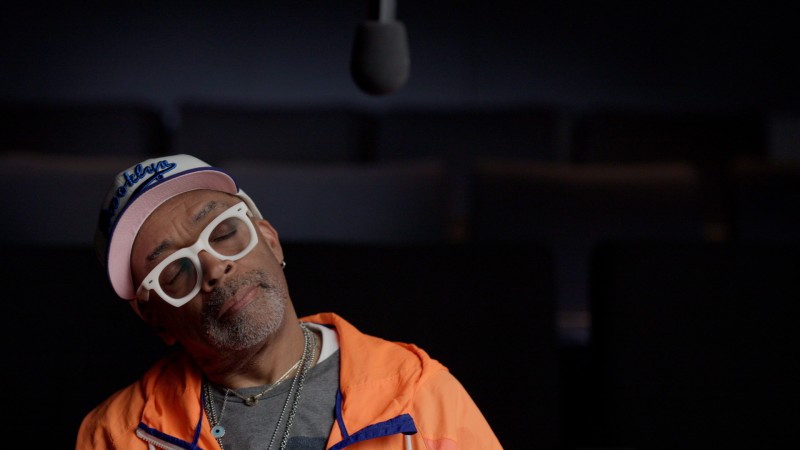The Shape of Corruption

For American audiences, Gomorrah (2008), Matteo Garrone’s no-exit view of mob domination in Naples, registers as a chilling urban apocalypse. (The title combines Sodom’s sister city and the Neapolitan Mafia known as Camorra.) For many residents of Italy’s Campania region, it’s just reality. And with its investigation into the sociopolitical hazards and economic underpinnings of southern Italian life, the film is a sizzling extension of Italy’s cinematic past, particularly Francesco Rosi’s trailblazing Salvatore Giuliano (1962).
Now that Garrone’s and Rosi’s film are streaming on the Criterion Channel on FilmStruck, I avidly watched them both again. Their thematic similarities are striking—especially their view of crime as a bulwark for the ruling class. What I found astonishing and thrilling was the way both directors marry journalistic rigor to a gritty imagistic splendor. Salvatore Giuliano was Rosi’s breakthrough film, and he and his team innovated a new style of filmmaking to trace the collision and collusion of Sicilian separatists, the Mafia, the cops, and the bandit antihero, Giuliano. As Rosi told me twenty years ago in an interview, “I was convinced that the only way in which I could have put together cause and effects was to structure Salvatore Giuliano as an investigation . . . I combined the style of a document with that of interpretation and the construction of fiction without ever losing the sense of truth which that film needed. That is why I decided to shoot in the real places where those events took place little more than ten years before. That is why I put together very few professional actors with many improvised actors chosen in the streets and houses of those places.” (Garrone mixes amateur, semiprofessional, and nonactors from the area, including a Camorra crime-family boss, with celebrated pros like Toni Servillo.)
Salvatore Giuliano sparked a new frankness about the Mafia that swept through Italian cinema, galvanizing directors young and old and exposing once-taboo secrets about Cosa Nostra. The veteran Alberto Lattuada played the tragic melodrama of Mafioso (also 1962) for prime black comedy, but he also rooted it in the factual story of a reluctant hit man. The young Elio Petri (The Tenth Victim) cunningly shaped We Still Kill the Old Way (1967) as a waking nightmare for a leftist academic who antagonizes Sicily’s unholy trinity of Mafia, Church, and State; the great Sicilian writer Leonardo Sciascia, a sometime politician with firsthand knowledge of his native land’s inertia and corruption, wrote the source novel, To Each His Own.
But Rosi took the most original and dynamic approach. Combining documentary and narrative-film techniques, he anticipated a wave of European directors that would emerge later in the sixties, who strived to bring a “you are there” feeling to recent history, including Gillo Pontecorvo and Costa-Gavras. His script was a machine-gun mosaic, fragmented yet propulsive, exciting in its revelations of Sicily’s hidden power structure and tangled criminal and legitimate partnerships. And his direction—particularly his passionate, uncanny visual reaction to rugged terrain—elevated a topical script into timeless art. As Rosi told me, “Great natural landscapes and certain immobile environments carry with them centuries of history; they often manage to offer a breath of ‘greatness’ to events that, because of human violence, would otherwise only provoke horror.”

Garrone achieves a similar blend of muckraking and mystery in Gomorrah, adapting Roberto Saviano’s explosive piece of neo–New Journalism. The book, also called Gomorrah, was hailed upon publication in 2006 as the best of the “New Italian Epics”—a term for socially engaged, artistically complex, and deeply subversive prose works that mix fictional and nonfictional techniques so thoroughly they’ve also been called “UNOs,” for Unidentified Narrative Objects. Garrone, collaborating with Saviano as part of a six-screenwriter team, creates his own individualistic brand of storytelling, mining Saviano’s book for themes and epiphanies that inform a handful of representative characters. At the low end of the spectrum, a thirteen-year-old boy retrieves a gun dropped during a police roundup and returns it to the mob owners, winning an audition for a local Camorra clan. In his first test, a thug shoots him at point-blank range while he’s wearing an alarmingly ragged bulletproof vest. At the high end, an educated young man apprentices to the chief of the Camorra’s toxic waste disposal racket. As the youth withholds his opinions on an ecological disaster in the making, we wonder whether he’ll be able to live with himself. Garrone depicts these main characters and three others moving through a landscape where the criminal syndicate dominates all of life. He proves that the Camorra is no subculture—itis the culture. Living with it in Naples is like being in an occupied country during wartime. You can join up or become a fellow traveler. You can keep your distance yet obey its orders and take its money for menial services. Or you can go into hiding. Otherwise, you die.
Salvatore Giuliano portrayed the shotgun marriage between right-wing political forces circa 1950 and the medieval hierarchies of crime families and Catholicism. Any vestige of feudalism has gone from Gomorrah’s Camorra. In Garrone’s film, the Neapolitan syndicate operates mostly out in the open as it feeds a global economy. The Camorra has pioneered its own influential kind of mob rule. Instead of the Sicilian (and American) Mafia’s pyramid structure, in which each family unit of soldiers and capos pays obeisance to a dominant clan like the Corleones or the Sopranos, the Camorra operates more like a loose-knit confederacy. Individual gangs or clans maintain a high degree of autonomy as they infiltrate working-class, lower-middle class, and middle-class communities. As the woe-eyed paymaster Don Ciro (Gianfelice Imparato) doles out money to families of men and women who’ve been killed or gone to prison, it’s as if we’re watching a welfare state working on the wrong side of the law. Gomorrah dramatizes how this looser, more spread-out organization, seemingly impenetrable, engenders violent infighting. The movie starts with a massacre that becomes the first battle in a war of secession, as one subgroup of kith and kin breaks off to establish its own dominion. Before long, everyone must take a side.
When Rosi died in 2015, Saviano tweeted, “No one knew how to portray power like Francesco Rosi.” And the master applauded Garrone’s rendering of Saviano’s book, praising the director’s “anthropological” focus during a location visit to the set of Gomorrah.Though Garrone never referred to Rosi as a predecessor or an influence, instead citing the segmented narrative and nonjudgmental probing of characters in Roberto Rossellini’s Paisan, Rosi and Garrone make a better aesthetic fit. Rosi’s alert eye feeds his responsiveness to the size, shape, texture, and emotional environment of each rural or urban landscape. His supreme command of architecture makes us feel as if we can intuit the dangers of Sicilian town squares and courtyards, day and night, in Salvatore Giuliano,and the vitality as well as the desolation in the Naples tenements in Hands Over the City. In Gomorrah, Garrone dares to be great in much the same way. A lot has been written about his tight focus on characters, but the brilliance of his close-to-the-skin camerawork lies in the way each setting unfolds, in turn, from each character’s point of view.
As Garrone’s camera jabs like a stiletto in and out of parallel story lines, it roots each warrior, victim, and would-be maverick or middleman in settings redolent of lived-in failure or futile ambition. The thirteen-year-old, Toto (Salvatore Abruzzese), roams the concrete plateaus of enormous housing projects in depressed, drug-dominated Scampia. Two surreal skyscrapers dominate the skyline, each resembling twinned post-modern ziggurats, with left- and right-hand sides connected by metallic beams that recall X-shaped, accordion style hat-racks and imbue the inside corridors with a helter-skelter otherworldly ambiance. It’s both ultramodern and obsolete-looking. Families occasionally stake out their own space as Camorra lookouts, drug dealers, junkies, and slackers of all ages dominate the structure. We’re surprised to see anything resembling normal domestic rituals occur in this breeding ground for desperation and criminality, whether it’s kids cavorting on a rooftop Astroturf playground or a wedding party ambling down a blue carpet in the main passageway.
Crime in a closed environment becomes grand opera in Coppola’s Godfather masterpieces and a glitzy spectacle in De Palma’s Scarface. Gomorrah is more like Scorsese’s Mean Streets on an epic scale. (It’s no surprise that the film’s first credit is “Martin Scorsese Presents.”) When Garrone introduces us to scrawny, hotheaded adolescent Sweet Pea (Ciro Petrone) and his muscular best pal Marco (Marco Macor), it’s funny and frightening to hear them quote lines from the Scarface script. And it’s caustic to see them frolic in a spooky abandoned villa that real-life mob boss Walter Schiavone modeled on Tony Montana’s Miami mansion. Petrone registers like a live-wire squiggle on the screen. His Sweet Pea and Macor’s hyper-aggressive Marco are anarchic spirits at large in a spiritually hollow, numbingly material universe. They tell each other “the world is ours,” as if repeating that line from Scarface will make it true. They don’t realize that the slogan is ironic.
Staying down and dirty, Gomorrah generates bleak magnetism from the partnerships Garrone forges with his actors. Garrone doesn’t inflate his characters into arch-villains or tragic failures. Together, he and his ensemble create indelible images of bravado and anguish. The movie lacks any conventional rooting interest, but because of the actors, we pull for the characters to survive, whether it’s a boy prematurely aching to become a made man, misfit adolescents dreaming of becoming kingpins themselves, a master dressmaker yearning for recognition and self-determination, or a paymaster straining to keep his modest job and preserve the status quo.
Garrone’s ability to individualize every character, no matter how clueless, immoral, or seedy, humanizes every social stratum and electrifies the movie. Don’t expect a happy ending for anyone. Gomorrah never goes soft. But as in a Rosi masterpiece, the acute observations and masterly architectonics—the meshing of images, staging, and performances with felt life—produce a state of cinematic elation.





